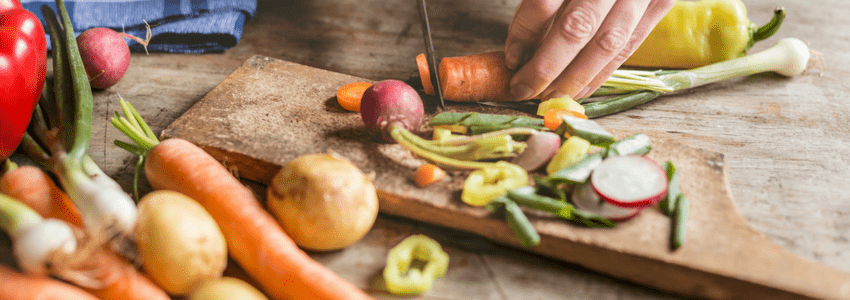Hands up, who finds cooking healthy meals for one an absolute hassle?
It’s not so bad when you have a partner or an entire family to feed. After all, most recipes cater for at least three or four people. But when you’re living alone, or your partner is out of town, cooking a healthy meal seems like so much effort.
Making just one meal doesn’t seem to justify the whole rigmarole of shopping, preparing, and cooking does it? And then there are the inevitable leftovers. It’s so hard to adjust a recipe to a single portion!
It all makes the pre-packaged meals for one look like an enticing option.
But cooking healthy meals for one doesn’t have to be a hassle!
We’ve compiled a downloadable cheat sheet for reducing recipes, along with some killer tips to make single meal cooking a breeze.
 Step by Step: How to Plan for One
Step by Step: How to Plan for One
When cooking for one, it’s important to have a plan.
If you enjoy grocery shopping, look a day or two ahead and make multiple trips to the store each week. If you’re not such a fan, you may want to plan on one large weekly shopping trip.
- Plan your meals: Know what foods you want to eat for the week. By figuring out what meals you need to shop for, you can break those meals down by ingredient. This streamlines your shopping trip and helps to prevent impulse buys.
If you’re stuck for meal inspiration, the internet is a great place to start looking for recipe ideas. You can even filter your search for single portion meals. We’ve also created a couple handy boards on our Pinterest page to help get you going! - Use your pantry: Being solo doesn’t mean you have to cook one meal at a time. When you’re planning meals, try to create dishes with common elements so you can cook things like grain or protein in bulk. If you cook a large batch of quinoa, you can use it throughout the week for a side, as the base for a grain and protein bowl, or to sprinkle on top of a salad for texture and protein.
- Prep like a boss: If you know that you have a busy week coming up (or just don’t like prepping a meal every day) try making a week’s worth of meals in one go. Say on a Sunday afternoon, when you have a little free time. Then store them in the fridge for when you need them. If you stick to simple, healthy recipes, it won’t take too long and will ensure you don’t give in to a mid-week junk food craving.
Kitchen Equipment To Stock Up On
Set yourself up for success in the kitchen by making sure you have everything you need to cook, season, and store your meals.
Here are a few things that will make life in the kitchen a little easier.
Slow cooker
Set it up in the morning, walk away for the day and return to a wonderful dinner. Many recipes are designed as “dump and go,” while others require a little more work. Either way, using a slow cooker is a great way to get dinner made without slaving over a hot stove for hours.
Rice cooker
Rice is notoriously finicky to cook properly, but rice cookers have it down pat. They do a really great job of cooking other grains like quinoa too. And some rice cookers also come with steamers that you can attach!
Muffin tins
Muffin tins are a great way to individually portion food. Try making a batch of tiny quiches and freezing them for later. Take two or three portions out as needed and reheat them in the oven or microwave while you whip up a side salad, and dinner is served!
Ice cube tray
Have you ever had a recipe that called for a cup of wine or a tablespoon of fresh herbs, only to find yourself with more leftover than you know what to do with? No longer a one-trick pony, these trays are perfect for freezing small portions to store and use later. Have a freezer bag filled with red wine cubes or leftover soup stock that you can take from as needed. Or chop up fresh herbs and freeze them in oil. That way when you need a teaspoon of thyme in a month or two, you don’t need to spend money on a whole new bunch!
Blender
Smoothies have definitely been key to the blender’s revived popularity. But blenders are good for so much more than just smoothies. They can also be used to blend and puree sauces, soups, and dressings. If a traditional blender is too big for your needs, look into something smaller like a NutriBullet or MagicBullet. They’re also super easy to clean! Just put a drop of dish soap in with some water, give it a whiz with the lid on tight, and rinse!
Food processor
The secret to cutting and chopping in seconds is the food processor. If you have mobility issues with your hands or arms, a food processor could be your saving grace. Many stick/wand blenders come with food processor attachments now, and lots are even dishwasher safe.
Pantry staples
It’s not really equipment, but pantry staples like spices, oils, and vinegar are an important part of your kitchen arsenal. Salt and pepper, garlic, onion powder, lemon juice, and flour are just a few things you can keep on hand that make a huge difference in flavor and texture.
How to Reduce Recipes
Perhaps the most difficult aspect of cooking for one is reducing a family size recipe down to a single serving. You can take a guess… and risk having a kitchen nightmare on your hands. Or you can download this super handy conversion chart we’ve created for you.
Tip: Print it out and pin it on your fridge!

*Temperature, cooking times, size of cookware, and seasonings may vary when reducing recipes. Monitor your food to determine whether further changes are necessary.
The Vital Components of a Healthy Diet
As we age, the need for calories is reduced. But this creates a nutritional dilemma because older folks need the same, if not more, nutrients than younger people.
According to the 2015–2020 Dietary Guidelines for Americans, any man over the age of 60 should be eating 2,000 calories a day. Women should aim for 1,600 calories. And those are recommendations for a completely sedentary person. If you’re moderately active, add 200 calories a day. And if you’re highly active, tack on an additional 400 calories.
But a paper published in the Journals of Gerontology shows that many people aren’t reaching their daily targets. Comparing the caloric intake of people in their 20s to people in their 80s, men consumed 1,000–1,200 fewer calories a day over time. And women consumed 600–800 fewer calories. By 80, 10% of men take in 890 calories or less a day, and women consume 750 calories or less.
What that means is that older people are eating roughly half their recommended daily caloric intake and are missing out on countless nutrients every day.
Finding and maintaining a healthy body weight as we get older reduces the risk of developing chronic diseases, like high blood pressure, diabetes, and hypertension. And the key is finding a balance between nutrient-rich foods and caloric intake.
Fortunately, the USDA has a new tool called ChooseMyPlate designed to help you find that balance. ChooseMyPlate offers a ton of resources for the whole family. From nutritional information on certain foods to meal plans and even budget tips. It also features the SuperTracker site, which allows you to track your activity, food intake, and set personal goals.
The USDA and the National Institute on Aging recommend people over the age of 50 aim for the following every day:
- fruit — 1½ to 2½ cups
- vegetables — 2 to 3½ cups
- grains — 5 to 10 ounces
- protein — 5 to 7 ounces
- dairy — 3 cups*
- healthy fats — 5 to 8 teaspoons
*The current guidelines recommend low-fat and non-fat dairy options, but research shows full-fat dairy may not be as bad for your health as previously believed.
When you’re meal planning, try to include foods that are rich in the following nutrients:
Protein
The average adult loses 3–8% of their muscle mass every decade after the age of 30. This muscle wasting, also known as sarcopenia, can lead to fractures as we become weaker and more prone to falls.
Protein makes up a significant part of the structural matrix of bone (50% of volume, 33% of mass). And protein is important in maintaining muscle mass as well as bone mineral density.
Current daily guidelines recommend 5 ½ ounces of protein as a part of a 2,000 calorie per day diet. You can also use this easy online protein calculator.
To learn even more about protein’s impact on bone health, check out our in-depth guide!
Calcium and Vitamin D
Calcium and vitamin D are crucial for bone health. And they work together in your body. Calcium helps build bone and vitamin D supports calcium absorption.
As you age, your body struggles to convert sunshine into vitamin D. Because your skin gets thinner over time, its ability to synthesize vitamin D diminishes. And because we know calcium and vitamin D depend on one other, if you’re having trouble synthesizing vitamin D, you’re also having trouble absorbing calcium.
Now, it can be difficult to get enough calcium and vitamin D into your diet. So taking supplements is a great way to make sure that you are. And supplements don’t come better than AlgaeCal Plus, which has these two crucial nutrients, added vitamins, and the 12 other essential minerals your bones crave.
Omega 3s
Omega 3 fatty acids are major players in cognitive function, healthy bones and joints, and reduced inflammation.
Additionally, research has shown omega 3 fatty acid fish oils can lower heart disease risk and lower blood pressure. As heart disease is a leading cause of death among the elderly, it’s a good idea to load up your diet with fatty coldwater fish like salmon and mackerel.
To make sure you’re getting enough every day, you might also consider supplementing with a fish oil, like AlgaeCal’s surprisingly tasty Triple Power Omega 3 Fish Oil. No fishy burps guaranteed!
Vitamin B12
B12 deficiency is widely recognized among seniors and is often the result of atrophic gastritis, a chronic form of intestinal inflammation. This form of inflammation affects 10–30% of Americans over the age of 65 and impairs your body’s ability to absorb protein-bound vitamin B12.
Vitamin B12 is also essential for healthy brain function and your body’s ability to make red blood cells.
Anyone following a vegan or vegetarian diet is especially prone to vitamin B12 deficiency because of its abundance in animal products like meat, fish, dairy, and eggs.
Takeaways
Cooking healthy meals for one doesn’t have to be a hassle after all! With the knowledge, you’ve gained from this post, a little bit of planning ahead, and maybe a few new equipment purchases it’ll be easy!
Challenge yourself to come up with new recipes (or check out our recipe section on the blog), to try new dishes, or even dive deeper into the spice rack than you’re used to.
Just make sure to hit each food group and pack in as much nutritional value as possible with a strong focus on bone-building nutrients like calcium, magnesium, vitamins C, D3, K2, B vitamins, omega 3 fatty acids, and protein.
Have you perfected the fine art of cooking for one? Do you have any tips and tricks you’d like to share with the AlgaeCal community? Tell us about your experience in the Comments section below.





Ladonna
May 19, 2018 , 9:38 amGood read. Thank you